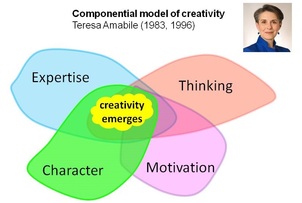
Prompted by Bud Cadells slideshare presentation
We tend to think of creativity as something discrete and separate from aspects of ourselves that are not creative but its more valuable to appreciate our creativity as something that is integral to what we bring to a situation and how we deal with it.
Terrasa Amabile (1983), who studied people working in the professional domain, viewed a person's creativity as the integration of their expertise, their ability to think creatively about domain relevant problems and opportunities, and their motivation which drives their will to engage with a domain relevant problem or opportunity and persist until the job is done. This perspective on creativity emphasizes its integrative nature: it's integral and inseparable from our capability to think and act. She also recognised a set of character traits like being committed, ambitious, driven, energetic, enthusiastic, displaying integrity and honest, being open and confident with strong, self-belief, and having a positive and optimistic orientation, willing to take on risks and to engage with challenge, that are associated with creative acts.
Bud Cadell's presentation highlighted another aspect of integration namely the way we combine more divergent and analytical thinking processes when we are creative. I endorse this perspective and would like to develop it through the integrative thinking model proposed by Puccio, Murdock, and Mance (2005). Using a problem solving situation to illustrate the thinking process they consider that specific cognitive and affective domains are activated and emphasised as the problem solving task moves from start to finish. For instance, In step 1, the individual assessing the situation, uses their curiosity to drive exploration of the problem and diagnostic skills such as analyzing, describing, and selecting to define the problem. Puccio et al note that openness to novelty, tolerance for ambiguity, and tolerance for complexity underlie all stages of creative problem solving.
In life we are at our most creative when we are challenged or inspired by situations that enable us to think in an integrative way. The same is true for educational designs that invite learners to use their creativity.
We tend to think of creativity as something discrete and separate from aspects of ourselves that are not creative but its more valuable to appreciate our creativity as something that is integral to what we bring to a situation and how we deal with it.
Terrasa Amabile (1983), who studied people working in the professional domain, viewed a person's creativity as the integration of their expertise, their ability to think creatively about domain relevant problems and opportunities, and their motivation which drives their will to engage with a domain relevant problem or opportunity and persist until the job is done. This perspective on creativity emphasizes its integrative nature: it's integral and inseparable from our capability to think and act. She also recognised a set of character traits like being committed, ambitious, driven, energetic, enthusiastic, displaying integrity and honest, being open and confident with strong, self-belief, and having a positive and optimistic orientation, willing to take on risks and to engage with challenge, that are associated with creative acts.
Bud Cadell's presentation highlighted another aspect of integration namely the way we combine more divergent and analytical thinking processes when we are creative. I endorse this perspective and would like to develop it through the integrative thinking model proposed by Puccio, Murdock, and Mance (2005). Using a problem solving situation to illustrate the thinking process they consider that specific cognitive and affective domains are activated and emphasised as the problem solving task moves from start to finish. For instance, In step 1, the individual assessing the situation, uses their curiosity to drive exploration of the problem and diagnostic skills such as analyzing, describing, and selecting to define the problem. Puccio et al note that openness to novelty, tolerance for ambiguity, and tolerance for complexity underlie all stages of creative problem solving.
In life we are at our most creative when we are challenged or inspired by situations that enable us to think in an integrative way. The same is true for educational designs that invite learners to use their creativity.
 RSS Feed
RSS Feed